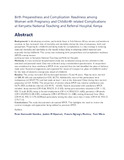Birth Preparedness and Complication Readiness among Women with Pregnancy and Childbirth related Complications at Kenyatta National Teaching and Referral Hospital, Kenya
Date
2020-06-28Author
Ihomba, Peter Kamwathi
Nyamari, Jackim M
Murima, Francis Ng'ang'a
Were, Tom
Metadata
Show full item recordAbstract
Background: In developing countries, particularly those in Sub-Saharan Africa, women and newborns continue to face increased risks of mortality and morbidity during the time of pregnancy, birth and postpartum. Preparing for childbirth and being ready for complications is a key strategy in reducing maternal mortality and morbidity as this would reduce delay in obtaining skilled maternal care especially during childbirth. This survey was evaluating birth preparedness and complication readiness (BPCR) among women
seeking services at Kenyatta National Teaching and Referral Hospital.
Methods: A cross-sectional hospital-based study was conducted among women admitted in the antenatal and postnatal ward. Data was collected using a standardised questionnaire. A respondent was considered to have satisfactory BPCR if she reported that she had identified the place of delivery, made prior financial arrangements and organised for means of transport to place of childbirth and/or for the time of obstetric emergencies ahead of childbirth.
Results: The survey recruited 353 women aged between 15 and 44 years. Majority were married (n=288, 81.6%) and unemployed (n=232, 65.7%). Additionally, most of the participants were multiparous (n=345,97.7%) and had made at least 1 visit at the Antenatal Clinic during their current pregnancy (n=331, 93.8%). The proportion of women whose BPCR was rated as satisfactory was 56.7% (95% confidence interval, (CI) 49.7% - 63.6%). Factors associated with satisfactory BPCR included: being married (OR10.66, 95%CI5.21-21.83), having post-secondary education (OR 11.52, 95% CI 6.62-20.05), being in formal employment (OR 4.14, 95%CI2.51-6.82), gestation >28 weeks (OR=1.83,95%CI1.08-3.09), multiparity (OR=1.87,95%CI1.21-2.88), visiting Antenatal Care Clinic (OR=9.31, 95% CI 2.70-32.09)and particularly visiting the clinic more than 2 times (OR=4.43, 95% CI 2.75-7.13).
Conclusions: The study documented sub-optimal BPCR. This highlights the need to review the current strategies and approaches being utilised to promote BPCR.
URI
https://doi.org/10.24248/eahrj.v4i1.618https://eahrj.eahealth.org/index.php/eah/article/view/618
http://ir-library.mmust.ac.ke/123456789/1598
Collections
- Gold Collection [1026]

